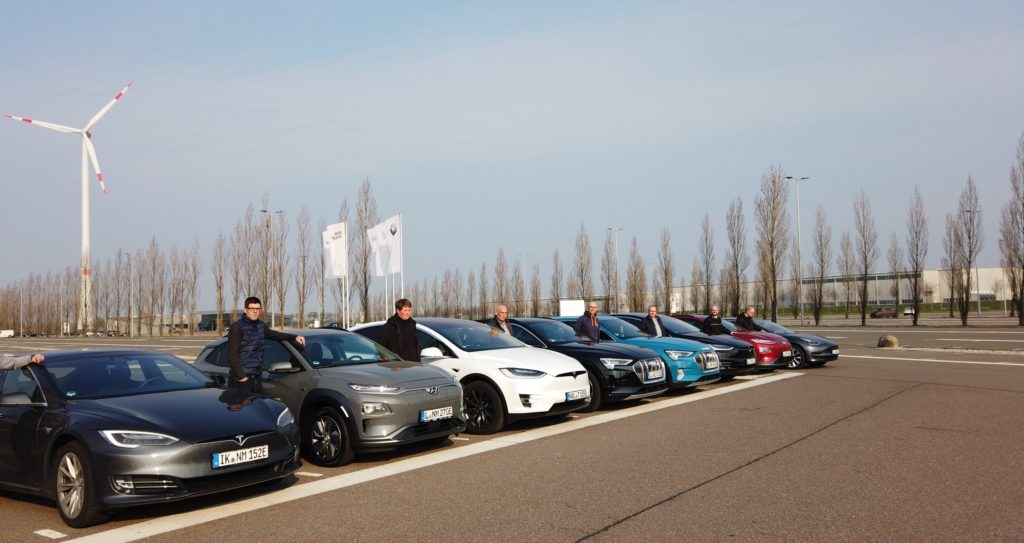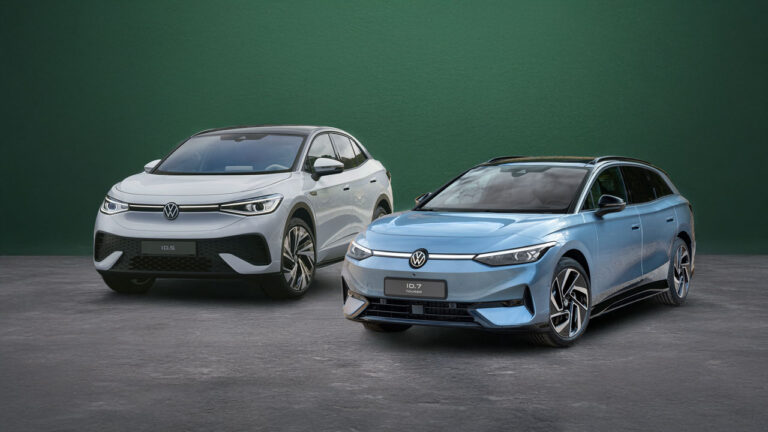[mp_row]
[mp_span col=“12″]
[mp_row_inner]
[mp_span_inner col=“12″]
[mp_video src=“https://youtu.be/GFRxfKY9u30″]
[/mp_span_inner]
[/mp_row_inner]
[mp_row_inner]
[mp_span_inner col=“12″ classes=“ motopress-space“]
[mp_space margin=“15,none,none,none“]
[/mp_span_inner]
[/mp_row_inner]
[mp_row_inner]
[mp_span_inner col=“12″]
[mp_text]
Germany’s leading EV rental company, nextmove, examined the efficiency and range of the Audi e-tron in comparison with the electric cars Model X, Model S and Model 3 from Tesla and the Hyundai Kona. The focus was on the duel between Audi e-tron and Tesla Model X. An earlier test by nextmove had shown that the Audi e-tron was clearly inferior to the Model X in terms of efficiency (23 percent more consumption). In a test of German car magazine ‘auto motor and sport’, on the other hand, the difference on the motorway was only six percent.
Author: Stefan Moeller, General Manager of nextmove
[/mp_text]
[/mp_span_inner]
[/mp_row_inner]
[mp_row_inner]
[mp_span_inner col=“12″ classes=“ motopress-space“]
[mp_space margin=“15,none,none,none“]
[/mp_span_inner]
[/mp_row_inner]
[mp_row_inner]
[mp_span_inner col=“12″]
[mp_text]
During the motorway test under the motto „Audi against the rest of the EV world“, attention was again paid to largely eliminating the influence of human factor and testing conditions. With ideal, slightly sunny weather and an outside temperature of 8 degrees Celsius, the nextmove home track around Leipzig was used for the two-part test. Driving was carried out at constant speed on a light traffic Sunday morning. Initially, all eight test vehicles drove at maximum 130 kph (81 mph) with an average speed of 115 kph (71 mph) due to traffic conditions. On the way back, the maximum speed was 150 kph (93 mph), as far as traffic permitted, at 130 kph (81mph) on average.
[/mp_text]
[/mp_span_inner]
[/mp_row_inner]
[mp_row_inner]
[mp_span_inner col=“12″]
[mp_image id=“6959″ size=“full“ link_type=“custom_url“ link=“#“ target=“false“ caption=“false“ align=“left“]
[/mp_span_inner]
[/mp_row_inner]
[/mp_span]
[/mp_row]
[mp_row]
[mp_span col=“12″ classes=“ motopress-space“]
[mp_space margin=“15,none,none,none“]
[/mp_span]
[/mp_row]
[mp_row]
[mp_span col=“12″]
[mp_row_inner]
[mp_span_inner col=“12″]
[mp_text]
The following electric vehicles took part in the highway test: two Audi e-tron (21 inch summer tires), two Tesla Model X 100D (19 inch winter tires and 20 inch summer tires), two Hyundai Kona (64 kWh, 17 inch winter tires and 17 inch summer tires) as well as one Tesla Model S 100D (19 inch winter tires) and one Tesla Model 3 (Dual Drive/Long Range, 19 inch summer tires). The tire pressure for all vehicles has been set to the manufacturer’s recommended value at maximum load. All eight drivers were experienced electric car drivers and knowing how to control their vehicle efficiently. Experience has shown that this is particularly important with the Audi e-tron: Someone who knows the car can drive much more efficiently than someone who drives the car for the first time.
[/mp_text]
[/mp_span_inner]
[/mp_row_inner]
[mp_row_inner]
[mp_span_inner col=“12″]
[mp_image id=“6924″ size=“full“ link_type=“custom_url“ link=“#“ target=“false“ caption=“false“ align=“left“]
[/mp_span_inner]
[/mp_row_inner]
[mp_row_inner]
[mp_span_inner col=“12″ classes=“ motopress-space“]
[mp_space margin=“15,none,none,none“]
[/mp_span_inner]
[/mp_row_inner]
[mp_row_inner]
[mp_span_inner col=“12″]
[mp_text]
In order to create identical driving conditions, the cruise control was only used when the cruising speed (130 or 150 kph) was reached. On motorway journeys at constant speed, regenerative braking has no decisive effect on consumption. Nevertheless, regenerative braking was avoided as far as possible in order to drive the vehicles as efficiently as possible. Instead, the vehicle was rolled out with foresight in order not to waste any energy. Heating and ventilation were switched off during the entire test – only the use of seat heating was permitted. During the trip, all drivers were connected via radio. Due to a motorway blockage, the originally planned complete lap was somewhat shortened.
[/mp_text]
[/mp_span_inner]
[/mp_row_inner]
[/mp_span]
[/mp_row]
[mp_row]
[mp_span col=“12″]
[mp_text]
Consumption comparison at 130 kph
The comparison of the EV at 130 kph (81 mph) showed a fuel consumption range between 18.5 and 28.4 kilowatt hours per 100 kilometers (29.8 to 45.7 kWh/100mi). In addition to the Tesla Model 3 as the efficiency winner, the Hyundai Kona on summer tires also stood out with 19.1 kWh consumption. The Tesla Model S, on the other hand, with 20.4 kWh consumption, was even a little more efficient than the Hyundai Kona on winter tires with 20.7 kWh. It is also interesting that the different tires of the Model X only led to a minimal deviation (23.8 vs. 24.1 kWh). The Audi e-tron with digital and classic exterior mirrors achieved the first round with consumption values of 27.5 and 28.4 kWh respectively.
[/mp_text]
[/mp_span]
[/mp_row]
[mp_row]
[mp_span col=“12″]
[mp_image id=“6960″ size=“full“ link_type=“custom_url“ link=“#“ target=“false“ caption=“false“ align=“left“]
[/mp_span]
[/mp_row]
[mp_row]
[mp_span col=“12″ classes=“ motopress-space“]
[mp_space margin=“15,none,none,none“]
[/mp_span]
[/mp_row]
[mp_row]
[mp_span col=“12″]
[mp_row_inner]
[mp_span_inner col=“12″]
[mp_text]
Consumption at 150 kph: Model 3, Hyundai Kona and Model S at the top
The motorway test at higher speed did not change the order of efficiency. The clear winners are Model 3, Kona and Model S due to their lower weight and better aerodynamics. Consumption ranged between 20.9 and 23.6 kWh. The four SUV consumed between 27.2 kWh (Model X, winter tires) and 30.8 kWh (e-tron, classic mirrors).
[/mp_text]
[/mp_span_inner]
[/mp_row_inner]
[mp_row_inner]
[mp_span_inner col=“12″]
[mp_image id=“6961″ size=“full“ link_type=“custom_url“ link=“#“ target=“false“ caption=“false“ align=“left“]
[/mp_span_inner]
[/mp_row_inner]
[/mp_span]
[/mp_row]
[mp_row]
[mp_span col=“12″ classes=“ motopress-space“]
[mp_space margin=“15,none,none,none“]
[/mp_span]
[/mp_row]
[mp_row]
[mp_span col=“12″]
[mp_row_inner]
[mp_span_inner col=“12″]
[mp_text]
Tesla Model X vs. Audi e-tron
The direct comparison between Tesla Model X and Audi e-tron showed clear differences in consumption also this time. In order to achieve even more reliable results, two vehicles of each type were used. By doing so, nextmove wants to set a new standard for consumption tests – in order to eliminate as many sources of error as possible.
[/mp_text]
[/mp_span_inner]
[/mp_row_inner]
[mp_row_inner]
[mp_span_inner col=“12″]
[mp_image id=“6946″ size=“full“ link_type=“custom_url“ link=“#“ target=“false“ caption=“false“ align=“left“]
[/mp_span_inner]
[/mp_row_inner]
[/mp_span]
[/mp_row]
[mp_row]
[mp_span col=“12″]
[mp_row_inner]
[mp_span_inner col=“12″ classes=“ motopress-space“]
[mp_space margin=“15,none,none,none“]
[/mp_span_inner]
[/mp_row_inner]
[mp_row_inner]
[mp_span_inner col=“12″]
[mp_text]
It is interesting to note that the difference in energy consumption at lower speeds is much more in favor of the Tesla Model X (17 percent) than at higher speeds (12 percent). Compared to the first nextmove test with the Audi e-tron pre-production car, which showed a difference of 23 percent, the results are now slightly or significantly lower. However, all the test data indicate that the efficiency advantages of the Tesla Model X are more pronounced than the results of the ‘auto motor and sport’ test (6 percent).
[/mp_text]
[/mp_span_inner]
[/mp_row_inner]
[/mp_span]
[/mp_row]
[mp_row]
[mp_span col=“12″]
[mp_image id=“6957″ size=“full“ link_type=“custom_url“ link=“#“ target=“false“ caption=“false“ align=“left“]
[/mp_span]
[/mp_row]
[mp_row]
[mp_span col=“12″]
[mp_row_inner]
[mp_span_inner col=“12″ classes=“ motopress-space“]
[mp_space margin=“15,none,none,none“]
[/mp_span_inner]
[/mp_row_inner]
[mp_row_inner]
[mp_span_inner col=“12″]
[mp_text]
Range comparison: Tesla clearly in the lead
This shows that Tesla, with its many years of experience, currently has a clear lead when it comes to efficiency. But what does that actually mean for the range?
With a range of 428 or 480 kilometers (266 or 298 miles), the Model S is clearly taking the lead. The Model X and the Model 3 have almost the same range at both speed levels. The Kona manages 283 and 322 kilometers (176 and 200 miles) respectively.
[/mp_text]
[/mp_span_inner]
[/mp_row_inner]
[mp_row_inner]
[mp_span_inner col=“12″]
[mp_image id=“6962″ size=“full“ link_type=“custom_url“ link=“#“ target=“false“ caption=“false“ align=“left“]
[/mp_span_inner]
[/mp_row_inner]
[mp_row_inner]
[mp_span_inner col=“12″ classes=“ motopress-space“]
[mp_space margin=“15,none,none,none“]
[/mp_span_inner]
[/mp_row_inner]
[mp_row_inner]
[mp_span_inner col=“12″]
[mp_text]
In last place is the Audi e-tron, which only achieves a range of 275 kilometers (171 miles) at faster speeds and should achieve just 300 kilometers (186 miles) at slower speeds. This is apparently currently the barrier for vehicles such as the Jaguar I-Pace, the Audi e-tron and the Mercedes EQC, which has not yet been broken through significantly. Future generations of vehicles from premium manufacturers will have to make significant progress here.
[/mp_text]
[/mp_span_inner]
[/mp_row_inner]
[mp_row_inner]
[mp_span_inner col=“12″]
[mp_image id=“6963″ size=“full“ link_type=“custom_url“ link=“#“ target=“false“ caption=“false“ align=“left“]
[/mp_span_inner]
[/mp_row_inner]
[/mp_span]
[/mp_row]
[mp_row]
[mp_span col=“12″ classes=“ motopress-space“]
[mp_space margin=“15,none,none,none“]
[/mp_span]
[/mp_row]
[mp_row]
[mp_span col=“12″]
[mp_row_inner]
[mp_span_inner col=“12″]
[mp_text]
Conclusion of the test Audi e-tron against the rest of the EV world
Tesla, which is no big surprise, is currently the benchmark in terms of efficiency and range. The greater experience of Tesla compared to Audi and the greater battery size compared to Hyundai clearly prevail.
We would like to thank all test drivers for their time and discipline in meeting the stringent requirements. The only minor consumption differences between the cars of the same type show that the results are not random, but real under these test conditions.
[/mp_text]
[/mp_span_inner]
[/mp_row_inner]
[mp_row_inner]
[mp_span_inner col=“12″ classes=“ motopress-space“]
[mp_space margin=“50,none,none,none“]
[/mp_span_inner]
[/mp_row_inner]
[/mp_span]
[/mp_row]
[mp_row]
[mp_span col=“12″]
[mp_text]
Press articles about this test
- Electrek: Tesla dominates EV efficiency at high speed, shows extensive test against Kona EV and Audi e-tron
- Teslarati: Tesla Model S, 3, X takes on Audi e-tron in Autobahn range and efficiency test
- Reddit: Power Consumption comparison: Audi e-tron, Tesla Model S 3 X, Hyundai Kona – done by nextmove
- Handelsblatt Edison: Tesla schlägt Audi
- Teslamag: Verbrauchsvergleich von E-Autovermietung: Tesla Model 3 vorn, Audi e-tron Letzter
- Forococheselectricos: Los Tesla Model S, 3 y X miden su eficiencia con el Audi e-tron y Hyundai Kona eléctrico en esta comparativa
- Teslamagazin: Porovnávací test spotreby pri diaľničnej rýchlosti: Tesly proti Audi e-tron a Hyundai Kona
[/mp_text]
[/mp_span]
[/mp_row]


